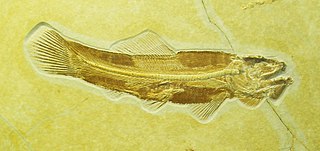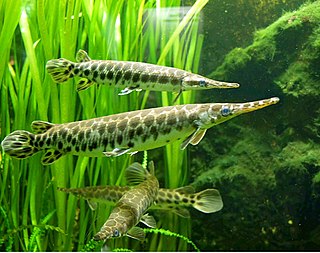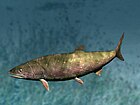
The Amiiformes order of fish has only two extant species, the bowfins: Amia calva and Amia ocellicauda, the latter recognized as a separate species in 2022. These Amiiformes are found in the freshwater systems of North America, in the United States and parts of southern Canada. They live in freshwater streams, rivers, and swamps. The order first appeared in the Triassic, and the extinct members include both marine and freshwater species, many of which are morphologically disparate from bowfins, such as the caturids.

Semionotiformes is an order of ray-finned fish known from the Middle Triassic (Anisian) to the Late Cretaceous (Maastrichtian). Their closest living relatives are gars (Lepisosteidae), with both groups belonging to the clade Ginglymodi within the Holostei. The group includes both freshwater (Semionotidae) and marine adapted forms. Many members of the family Macrosemiidae, had elongated dorsal fins, often associated with an adjacent area of skin which was free of scales. These fins were likely undulated for use in precision swimming. The body morphology of macrosemiids suggests that they were slow swimmers who were capable of maneuvering around complex topography, such as reef environments.

The Amiidae are a family of basal ray-finned fishes. The bowfin and the eyespot bowfin are the only two species to survive today, although additional species in all four subfamilies of Amiidae are known from Jurassic, Cretaceous, and Eocene fossils.

Lepisosteiformes is an order of ray-finned fish and the only living members of the clade Ginglymodi. Its only extant representatives are the gar, and it is defined as all members of Ginglymodi that are more closely related to gar than to the extinct Semionotiformes, the other major grouping of ginglymodians. They are one of two extant orders in the infraclass Holostei alongside the Amiiformes.

The Sao Khua Formation is a middle member of the Khorat Group. It consists of an alteration of pale red to yellowish-gray, fine to medium-grained sandstone and grayish-reddish brown siltstone and clay. Rare pale red to light gray conglomerates, containing carbonate pebbles, are also characteristic of this formation. This geological formation in Thailand dates to the Early Cretaceous age, specifically the Valanginian through Hauterivian stages.
Siamamia is an extinct genus of ray-finned fish in the family Amiidae. They are halecomorph fishes endemic to Early Cretaceous freshwater environments from north-eastern Thailand.

Calamopleurus is a prehistoric genus of marine halecomorph ray-finned fish from the Early Cretaceous of South America and northern Africa. It was a relative of the modern bowfin, with both belonging to the family Amiidae.

The Early Cretaceous Phu Kradung Formation is the lowest member of the Mesozoic Khorat Group which outcrops on the Khorat Plateau in Isan, Thailand. This geological formation consists of micaceous, brown to reddish-brown siltstone beds with minor brown and grey shale and sandstone beds. Occasional lime-noduled conglomerate occurs.
The Khok Kruat Formation is a rock formation found in northeastern Thailand. It is the uppermost formation of the Khorat Group. It is dated to the Aptian stage of the Early Cretaceous period, and is notable for its fossils of dinosaurs. It is equivalent to the Gres superieurs Formation of Laos. The group is a fluvial formation consisting primarily of red siltstones and sandstones.

Scheenstia is an extinct genus of neopterygian ray-finned fish from the Late Jurassic–Early Cretaceous of Europe. Fossils have been found in both marine and freshwater environments.

Halecomorphi is a taxon of ray-finned bony fish in the clade Neopterygii. The only extant Halecomorph species are the bowfin and eyespot bowfin, but the group contains many extinct species in several families in the order Amiiformes, as well as the extinct orders Ionoscopiformes, Panxianichthyiformes, and Parasemionotiformes. The fossil record of halecomorphs goes back at least to the Early Triassic epoch.

Tomognathus was a halecomorph fish related to the modern bowfin that lived in the Cretaceous Period. It was named by Dixon in 1850.

Pycnodontidae is an extinct family of ray-finned fishes, ranging from the Jurassic period until the Eocene. It was the largest and most derived family of the successful Mesozoic fish order Pycnodontiformes, and one of only two families to survive into the Cenozoic.
This list of fossil fishes described in 2017 is a list of new taxa of jawless vertebrates, placoderms, acanthodians, fossil cartilaginous fishes, bony fishes and other fishes of every kind that are scheduled to be described during the year 2017, as well as other significant discoveries and events related to paleontology of fishes that are scheduled to occur in the year 2017. The list only includes taxa at the level of genus or species.
This list of fossil fishes described in 2019 is a list of new taxa of jawless vertebrates, placoderms, acanthodians, fossil cartilaginous fishes, bony fishes, and other fishes of every kind that were described during the year 2019, as well as other significant discoveries and events related to paleoichthyology that occurred in 2019.
Varavudh Suteethorn, or Warawut Suteethorn is a Thai palaeontologist and geologist. He is the current director of the Palaeontological Research and Education Centre, Mahasarakham University. He is best known for his work on vertebrate paleontology in northeastern Thailand, having contributed to the discovery of many fossil taxa and dig sites in the Khorat Plateau, as a part of a long-standing collaboration between Thai and French scientists.

Ginglymodi is a clade of ray-finned fish containing modern-day gars (Lepisosteidae) and their extinct relatives in the order Lepisosteiformes, the extinct orders Semionotiformes and Kyphosichthyiformes, and various other extinct taxa. Ginglymodi is one of the two major subgroups of the infraclass Holostei, the other one being Halecomorphi, which contains the bowfin and eyespot bowfin and their fossil relatives.
Oniichthys is an extinct genus of gar in the family Lepisosteidae. It contains a single species, O. falipoui, known from the Late Cretaceous (Cenomanian) of Morocco.

The Akrabou Formation is a Late Cretaceous -aged geological formation and Konservat-Lagerstätte in Morocco. It overlies the slightly older freshwater deposits of the Kem Kem Group, which it was once thought to be apart of. It was deposited over following the Kem Kem ecosystem's submergence by the Tethys Ocean during a marine transgression from the Cenomanian-Turonian boundary event, as part of a wider deposition of carbonate platforms across the region from the event.















